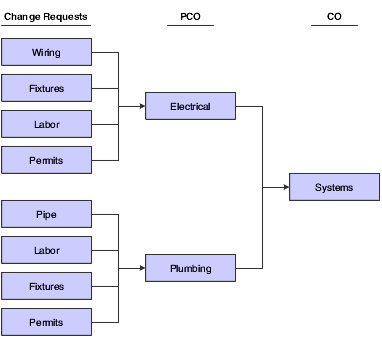Organizing Change Requests
Before you create any change requests for a job, you should decide how detailed you want the change request hierarchy to be. You can use a high level or a low level of detail. Whether you decide to use a high level or low level of detail, you can still attach related change requests to PCOs, and related PCOs to change orders (COs) to further organize the change requests.
A large job might have hundreds of changes. You can organize the changes in many ways to suit the needs of the business. For example, you can create hundreds of change requests, each of which has only a few line items, or you can create fewer change requests, each of which has many line items.
When you create hundreds of change requests, you create a change request hierarchy that has a high level of detail. Each change request in a high-detail level hierarchy is very specific. For example, you might create a change request that contains only line items for electrical wiring changes for the month of May, one that has wiring changes for June, one that has changes to fixtures for May, one with fixture changes for June, and so on. Each change request might have only a few line items, but you will need to keep track of many change requests.
This graphic shows an example of a hierarchy with a high level of detail:

When you create fewer change requests that each have many line items, you create a low-detail level hierarchy. For example, you might create a change request for all electrical changes. That one change request might contain changes for wiring, fixtures, labor, and permits over the entire course of the job. Such a change request probably has dozens of line items, but you only need to review one change request when you are searching for information or must modify a line item.
This graphic shows an example of a hierarchy with a low level of detail:
